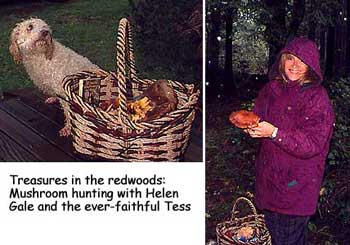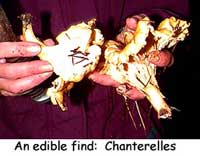People More People>
 When
Helen Gale, an amateur mycologist and longtime mushroom lover from
McKinleyville, California, invited us to go fungus hunting in Trinidad,
we jumped at the chance. Mushrooms, those mysterious forest treasures, are
best appreciated with a guide.
When
Helen Gale, an amateur mycologist and longtime mushroom lover from
McKinleyville, California, invited us to go fungus hunting in Trinidad,
we jumped at the chance. Mushrooms, those mysterious forest treasures, are
best appreciated with a guide.
It had been raining for three days straight when we headed into the woods with Helen and her canine companion Tess. "Rain is good for mushrooms, but when we get this much, it often waterlogs them," she said. Even so, our search was immediately fruitful. Using a knife to carefully dislodge each mushroom, Helen showed us the distinguishing features of several varieties and explained how important it is to gather complete specimens. "You have to have all the parts to identify them with certainty," she said, "And it's also important to note which trees the mushrooms grow near. Time of year is another identifying factor, and so are odor, color, texture..." It was immediately clear that people interested in mycology have a lot to learn, especially if they want to eat their finds. Poisonous mushrooms aften look virtually identical to their edible relatives.
 "These
are chanterelles," said Helen, showing us some large yellow mushrooms.
"They're good to eat." Later we discovered some orange peels,
another edible variety named for its uncanny resemblance to citrus rinds.
With a basket full of remarkable fungi, we headed back through the forest.
"These
are chanterelles," said Helen, showing us some large yellow mushrooms.
"They're good to eat." Later we discovered some orange peels,
another edible variety named for its uncanny resemblance to citrus rinds.
With a basket full of remarkable fungi, we headed back through the forest.
"I hope you can come to the Humboldt Bay Mycological Society's Mushroom Fair this weekend," said Helen. Some of these mushrooms will be on display, and you'll see lots of other kinds, too." We said we wouldn't miss it, and we didn't! Click here for a visit to the Mushroom Fair.
12/96
